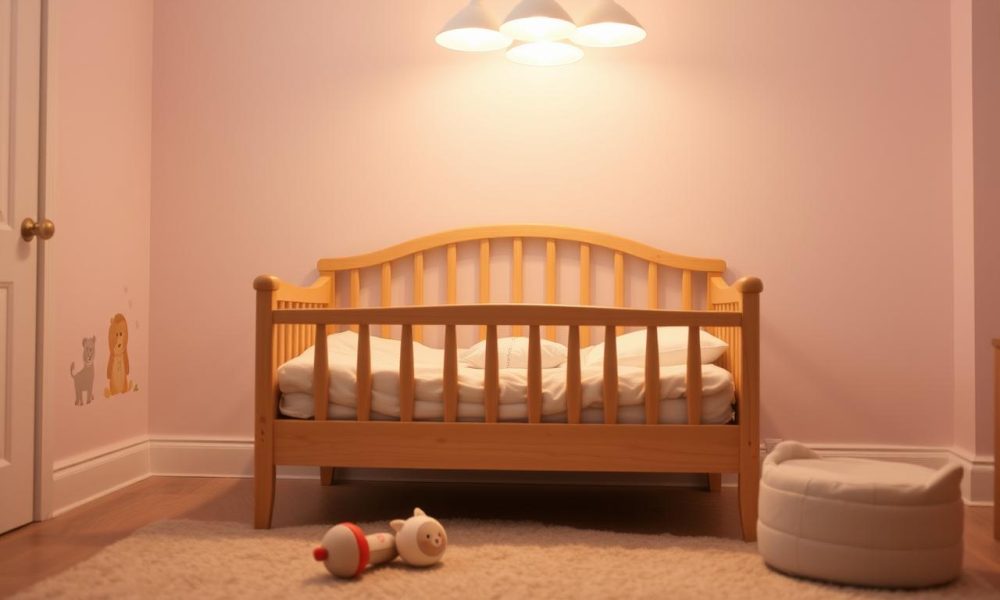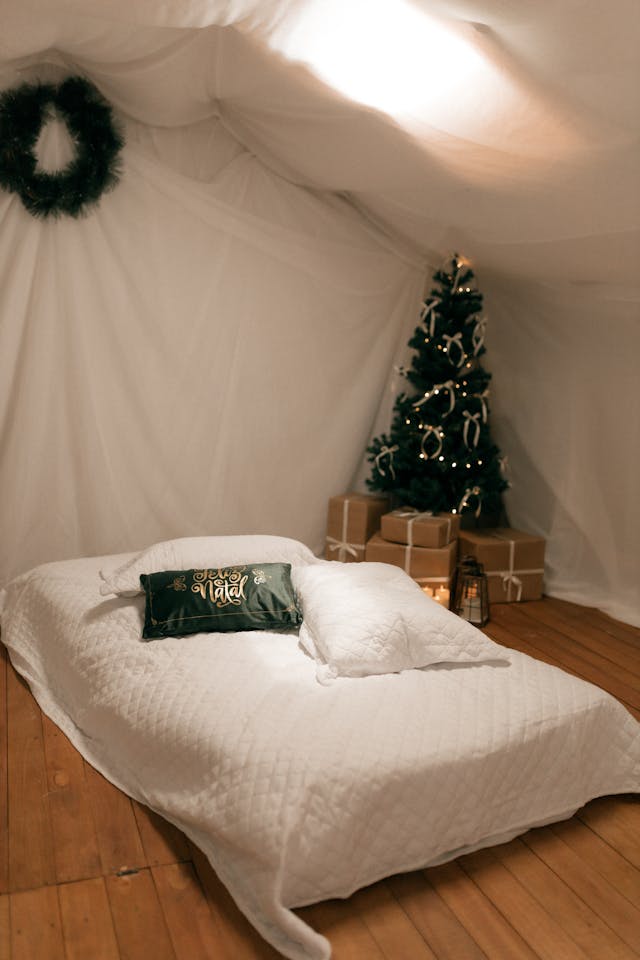Switching your child from a crib to a big kid bed is a big step. The right time for this transition is key. It affects their sleep and how well they adjust. Waiting until they’re almost 3 can mean fewer bedtime fights and better sleep.
Getting ready for this change means checking if your child is ready. Look for signs like climbing out of the crib or wanting a big kid bed. For tips on a smooth transition, check out the ultimate guide to the toddler bed.
Key Takeaways
- Wait until your child is closer to 3 years old for a smoother transition.
- Check for signs of readiness before making the switch.
- Involve your child in the process to make it more engaging.
- Maintain a consistent bedtime routine.
- Prepare the room for safety to prevent accidents.
Why Transition to a Toddler Bed?
Knowing when and how to switch your child to a toddler bed is key. It affects their sleep and comfort. As your child grows, certain signs show it’s time for a new bed.
Signs Your Child is Ready
Several signs mean your child is ready for a toddler bed. These include climbing out of the crib, being too big, and wanting a “big kid bed.” Climbing out of the crib is a big safety warning that it’s time to switch, as it can hurt them. If your child is near the crib’s weight or height limit, they need a bigger bed.
Benefits of Switching Early
Switching to a toddler bed early has many benefits. It helps your child get used to a big bed, making the change easier. Early transition also encourages independence and maturity. Plus, toddler beds are safe and comfy, with guardrails to stop falls.
Safety Considerations
Safety is very important when moving to a toddler bed. Make sure the bed meets safety standards for toddler beds. It should have strong guardrails on both sides to keep your child in. Also, place the bed in a safe spot, away from windows, curtains, and dangers.
By knowing when your child is ready and taking safety steps, you can make the switch to a toddler bed a success. This change is not just about growing up. It’s about making a safe and comfy sleep space for your child.
Choosing the Right Toddler Bed
Getting ready to move your child from a crib to a toddler bed is a big step. It’s important to pick the right bed for a smooth transition. You need to think about safety, comfort, and what your child likes.
Types of Toddler Beds
Toddler beds come in many styles, each with special features. You can pick from convertible beds that grow with your child, standard toddler beds for a cozy sleep, or themed beds to make bedtime fun.
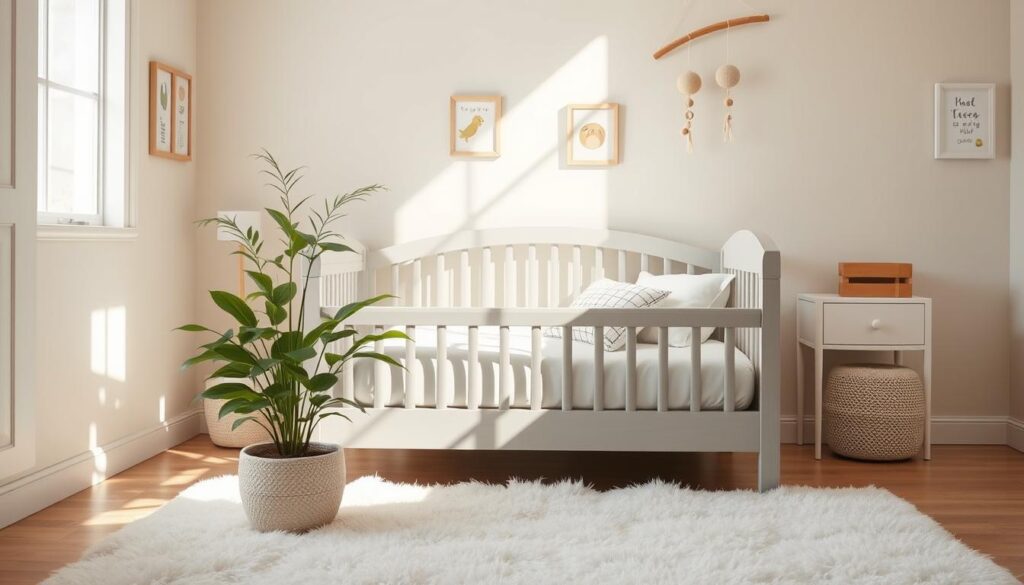
Features to Look For
When choosing a toddler bed, focus on a few key things. Safety is top priority; look for beds with guardrails and a strong frame. Comfort matters too; choose the right mattress size and type for support. Also, consider how easy the bed is to convert if it’s a convertible model.
Popular Brands to Consider
Many brands are known for their quality and safety. Pottery Barn Kids offers stylish and durable beds. Delta Children has a range of affordable, safe toddler beds. Graco is trusted for beds with advanced safety features.
When looking at toddler beds, you might wonder about the toddler bed vs crib debate. Cribs are for younger babies, but toddler beds are better for older toddlers. They offer more space and independence.
Preparing Your Child for the Transition
Helping your child get used to a toddler bed is important. You need to talk about the change, involve them, and make them excited about the new bed.
Talk About the Change
Telling your child about the change is the first step. Explain that a toddler bed is for big kids. Say something like, “You’re growing up, and big kids sleep in a special bed called a toddler bed.” Use simple and positive words to make it sound good.
Involve Them in the Decision
Letting your child help choose the bed makes them feel more involved. They can pick out the bed or bedding. This can be fun for both of you. For example, you can say, “Let’s pick out a special bed for you.” This makes them feel important and in control.
Create Excitement Around the New Bed
Make the new bed feel special. Let them help set it up or choose a favorite stuffed animal. Making the bed their own can help them feel less anxious.
| Strategy | Benefit |
|---|---|
| Talking about the change | Reduces uncertainty and anxiety |
| Involving them in the decision | Increases their sense of control and excitement |
| Creating excitement around the new bed | Makes the transition a positive experience |
By following these steps, you can make the transition to a toddler bed positive. Remember, be patient and consistent. With time, your child will get used to their new bed, and bedtime will become easier.
Setting Up the Toddler Bed Space
Transitioning to a toddler bed is more than just getting a new bed. It’s about making a safe and cozy sleep area. It’s important to make sure the room is safe and childproofed.
Ideal Room Arrangement
Think carefully about where to put the toddler bed. It should be away from windows and curtains. The room should also be well-ventilated and at a good temperature.
A clutter-free room helps reduce distractions. It makes the room peaceful, perfect for sleep.
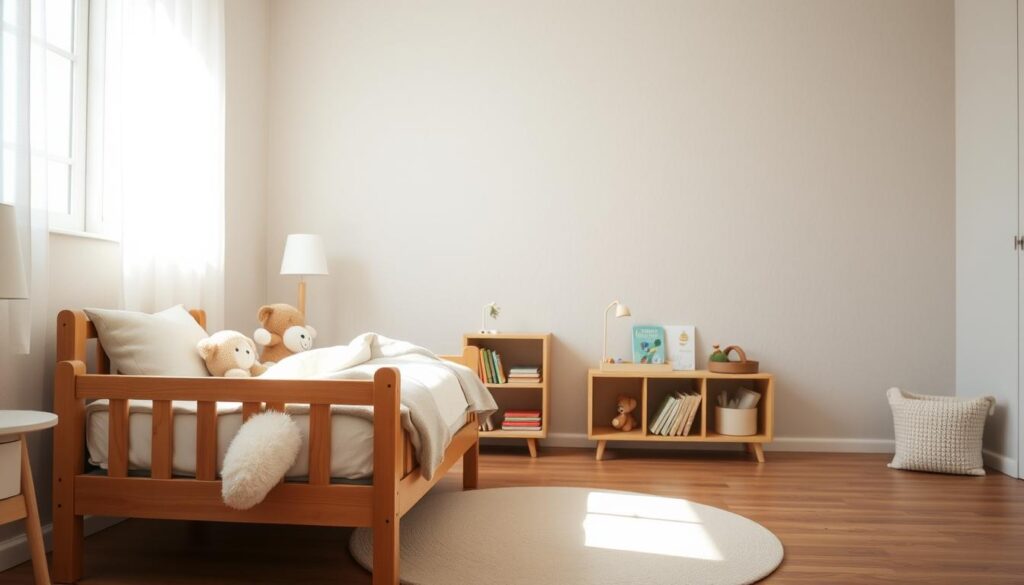
Bedding and Accessories Suggestions
Choosing the right bedding and accessories is key for toddler sleep training. Use a firm mattress and tight sheets to lower SIDS risk. Avoid soft toys, blankets, and pillows that could be dangerous.
Consider using a toddler bed guard rail to stop falls.
Safety Measures to Implement
It’s vital to focus on toddler bed safety. Make sure the room is safe by securing furniture and appliances. Use safety gates at the door to keep your child in the room.
Check the room often for hazards and fix them quickly.
By paying attention to these details, you can make a sleep area that’s safe and promotes good sleep habits for your toddler.
Making the Transition Smooth
Transitioning to a toddler bed can be smooth with the right strategies. These methods help both you and your child. A well-thought-out plan can lessen the stress of this change.
Establish a Familiar Routine
Keeping a consistent bedtime routine is key. It tells your child it’s time for sleep. This routine brings security and comfort in the new bed. For more tips, check our Ultimate Guide to the Toddler Bed.
Activities like bath time, reading, or singing can be part of this routine. The goal is to keep these activities the same. This way, your child knows what to expect.
Use Comfort Items
Comfort items are very important for a smooth transition. These could be a favorite toy, blanket, or any object that makes your child feel safe.
Having these items in the toddler bed helps your child feel more comfortable. It makes it easier for them to fall asleep.
Be Patient During Adjustments
Being patient is essential during this time. Your child might not like the change or wake up at night. They might need reassurance and comfort.
Patience and understanding are vital. With a consistent approach, your child will get used to the new bed over time.
Handling Sleep Disruptions
Switching from a crib to a toddler bed can cause sleep problems. But, there are ways to handle these issues. As your child gets used to the new bed, being ready for sleep challenges is important.
Common Challenges Faced
Children often struggle with the new bed. They might resist bedtime, wake up a lot, and feel anxious at night. Creating a consistent bedtime routine helps your child know it’s time to sleep.
Some common problems include:
- Not wanting to stay in bed
- Waking up and crying at night
- Being scared of the dark or the new place
Tips for Managing Nighttime Anxiety
Nighttime anxiety is common when moving to a toddler bed. To deal with this, introduce comfort items like a favorite toy or blanket. Also, make sure the bedroom is dark, quiet, and comfortable to help calm your child.
Strategies for Encouraging Sleep
To help your child sleep better, create a calming pre-sleep routine. This can include reading, singing, or a warm bath. Gradually transitioning to the new bed by starting with naps or having your child sleep in it for a few hours before full nights can also be helpful.
Being patient and consistent is key. It might take time for your child to get used to the new bed. So, it’s important to stick to the routine and make changes as needed.
Transitioning from Crib to Toddler Bed
Switching your child from a crib to a toddler bed is a big step. It’s not just about getting a new bed. It’s about making sure your child is safe and comfortable.
Timing the Move
The best time to move to a toddler bed varies. It usually happens between 18 months and 3.5 years. Look for signs like climbing out of the crib or wanting a “big kid” bed. For more help, check our ultimate guide to the toddler bed
Steps to Take During the Transition
Start by letting your child help choose the new bed or bedding. A consistent bedtime routine can also help them adjust.
Be patient as it takes time for them to get used to the new bed. Make sure the bed is safe and comfy.
What to Expect After the Change
After switching to a toddler bed, your child’s sleep might change. They might wake up more or have trouble falling asleep. Keep a bedtime routine and offer comfort items to help.
Watch how your child adjusts and be ready to make changes if needed. With patience, most kids get used to their new bed.
Maintaining Safety Post-Transition
Switching to a toddler bed is just the start. Keeping your child safe is a continuous effort. As they grow and become more independent, it’s key to keep their sleep area safe.
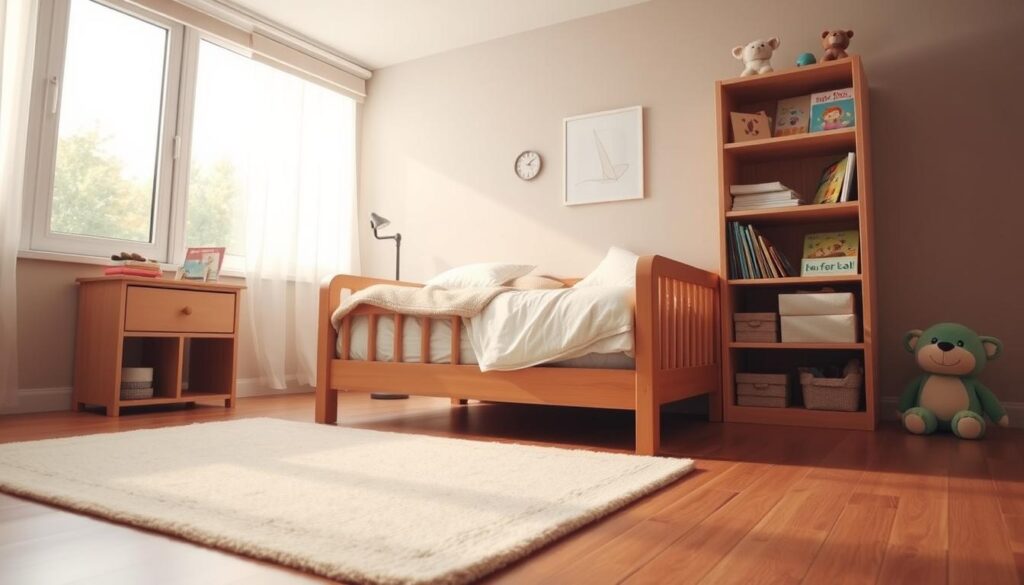
Toddler Bed Safety Tips
To keep your child safe in their toddler bed, consider these tips:
- Ensure the bed is placed away from windows and curtains.
- Use guardrails on both sides of the bed to prevent falls.
- Keep the bed free from soft bedding and toys that could pose a suffocation risk.
Guardrails are a must-have for toddler beds to prevent your child from rolling out during sleep. Make sure they are securely attached to the bed.
Childproofing Considerations
Childproofing the room is as important as the bed itself.
Secure any heavy furniture to the walls to prevent tip-overs, and ensure that electrical outlets are covered.
It’s also a good idea to remove any hazardous materials or objects from the room.
Monitoring Sleep Behavior
Watching your child’s sleep behavior after the transition is important. Look out for any changes in their sleep patterns or signs of distress.
By staying alert and keeping a safe sleep environment, you can ensure your child’s safety and well-being.
Celebrating Your Child’s New Bed
Getting a toddler bed is a big step for your child. To make it a good experience, celebrate the new bed. This helps make bedtime a happy time.
Making the Transition Memorable
Make the new bed special for your child. Let them choose new bedding or a favorite toy. This makes the bed a cozy spot and bedtime fun.
Involving Loved Ones
Get family and friends involved to make it exciting. Share the news and have them come to see the bed. For more tips, check out Thirsties Baby for help with the transition.
Positive Bedtime Associations
Start a bedtime routine to make bedtime good. Activities like reading or singing can help. This makes the new bed easier to get used to.

